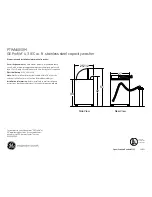
HOW TO LOAD YOUR WASHER
This illustration, with clothes just
reaching the Filter Ring shows a
proper load. Clothes have ample
room to move because they are not
packed down, nor wrapped around
the agitator. Clothes are loaded dry
since wet items are likely to pack
down which encourages
overloading. This size load
requires a full water
What is the best size load of
clothes—large, medium, or
small? Save time, energy and
detergent by avoiding extra use of
the washer. Try to wash a full load
of clothes. If you can it is better to
save clothes until you have a full
load. If you must wash smaller
loads, save water, energy and
detergent by adjusting the water
level for the size of the load. See
Operating Instructions.
Load clothes dry.
●
Take a properly sorted group of
clothes and drop them loosely in
the wash basket in this order:
Large Items–like sheets. Do
not wrap around the agitator.
Small Items–like washcloths.
Medium Size Items–like
towels.
To add items after the washer
has started:
●
Turn off the washer.
●
Add any additional articles by
submerging next to the agitator.
●
Restart the washer.
NOTE: When washing stockings,
panty hose and other easily tangled
items, always handle separately. To
minimize tangling, we recommend
the use of a net laundry bag.
Special Recommendations for Washing Permanent Press If You Do Not Have a Dryer
If you are machine-washing Permanent Press clothes
●
Use more water than you would for a regular
that you plan to line dry or drip-dry, use extra care to
load. Use a Medium Water Level for a Small Load;
minimize wrinkling in the wash process:
a Full Water Level for a Medium Load.
●
Be careful not to overload washer. Permanent Press
●
Remove clothes promptly as soon as washer stops
clothes must have ample room to move freely. A
and hang immediately.
Medium size Permanent Press load is the largest that
should be washed.
If your clothes and household items
don’t look clean and fresh after
washing, you will probably rewash
them., and that means you’ll waste
energy. Remember to sort your
clothes carefully, and load them
properly, select correct cycles, use
enough detergent and
water temperature warm enough
to release and get rid of soil.
●
Use Hot Wash—up to
on a regular basis
only when washing heavily
soiled articles-such as work
and play clothes.
●
Under normal soil conditions,
wash in water above
This generally
means using the Warm Wash
Temperature setting on your
washer—temperatures
approximately 90
or hand
comfortable. If you notice
that soil has accumulated after
several consecutive washings,
use Hot Wash occasionally, if
safe for fabrics.
●
Try to wash less often. Save
articles of the same type of
fabric until you have a full load.
●
If you must wash smaller
loads, adjust the amount of
water. Small loads should have
lower water levels.
●
Wash in off-peak utility hours.
Your local utility can tell you
which are the off-peak hours.
●
Use Normal (Fast) Spin Speed
to remove more water and help
lessen drying time. The dryer will
remove any wrinkles caused by –
the Fast Spin.
10










































